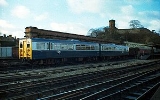
British Rail Class 140
Encyclopedia
The British Rail
Class 140 was the prototype of the Pacer
diesel multiple unit
. Much of the bodywork was constructed using Leyland National
bus components, with the exception of the cabs, in 1980.
Based on the single car railbus prototypes
, the class 140 was built to BR's then stringent regulations regarding crashworthiness and resistance to end loading in 1980. This meant that it lost its lightweight 'bus on a wagon' look and was much more substantial.
The original traction power train consisted of a Leyland TL11 200 HP engine, a Self Changing Gears mechanical automatic gearbox and a Gmeinder
final drive unit on each car driving only one axle.
The sole member of the class, No. 140001, formed of cars 55500+55501, has been preserved and is currently at the Keith and Dufftown Railway
. The Class 140 formed the basis of the design of the production Pacer sets of Class 141
introduced in 1984 and Class 142
introduced in 1985.
British Rail
British Railways , which from 1965 traded as British Rail, was the operator of most of the rail transport in Great Britain between 1948 and 1997. It was formed from the nationalisation of the "Big Four" British railway companies and lasted until the gradual privatisation of British Rail, in stages...
Class 140 was the prototype of the Pacer
Pacer (train)
Pacer is the operational name of the British Rail Classes 140, 141, 142, 143 and 144 diesel multiple unit railbuses, built between 1984 and 1987...
diesel multiple unit
Diesel multiple unit
A diesel multiple unit or DMU is a multiple unit train consisting of multiple carriages powered by one or more on-board diesel engines. They may also be referred to as a railcar or railmotor, depending on country.-Design:...
. Much of the bodywork was constructed using Leyland National
Leyland National
The Leyland National is a British single-deck bus built in large quantities between 1972 and 1985. It was developed as a joint project between two UK nationalised industries - the National Bus Company and British Leyland. Buses were constructed at a specially built factory at the Lillyhall...
bus components, with the exception of the cabs, in 1980.
Based on the single car railbus prototypes
British Rail Railbuses
British Rail produced a variety of Railbuses as a means both of building new rolling stock cheaply, and to provide services on lightly used lines economically.-Terminology:...
, the class 140 was built to BR's then stringent regulations regarding crashworthiness and resistance to end loading in 1980. This meant that it lost its lightweight 'bus on a wagon' look and was much more substantial.
The original traction power train consisted of a Leyland TL11 200 HP engine, a Self Changing Gears mechanical automatic gearbox and a Gmeinder
Gmeinder
Gmeinder GmbH was a German locomotive and engineering company based in Mosbach. Its products included diesel engines, small locomotives and other railway locomotive parts...
final drive unit on each car driving only one axle.
The sole member of the class, No. 140001, formed of cars 55500+55501, has been preserved and is currently at the Keith and Dufftown Railway
Keith and Dufftown Railway
The Keith and Dufftown Railway is a heritage railway in Scotland, running for from Keith Town railway station, Keith to Dufftown railway station, Dufftown via Drummuir ....
. The Class 140 formed the basis of the design of the production Pacer sets of Class 141
British Rail Class 141
The British Rail Class 141 was the first production model of the Pacer diesel multiple units.-Description:In the early 1980s British Rail were looking to replace the remaining 1950s first generation Diesel Multiple Units on lightly used branchlines...
introduced in 1984 and Class 142
British Rail Class 142
The British Rail Class 142 is a class of Pacer diesel multiple units used in the United Kingdom. 96 units were built by BREL in Derby between 1985 and 1987. They were a development of the earlier Class 141 which were introduced in 1984....
introduced in 1985.

